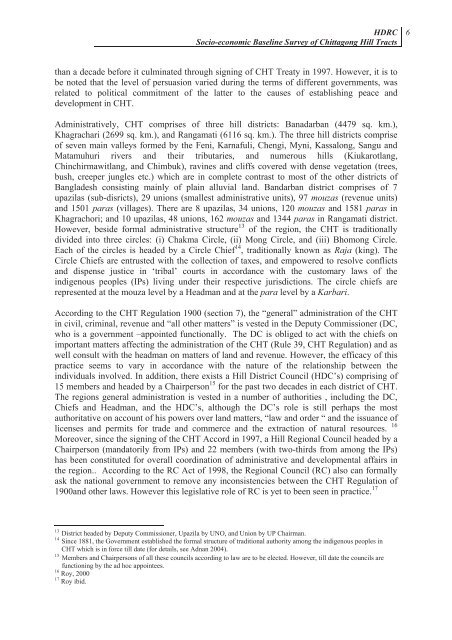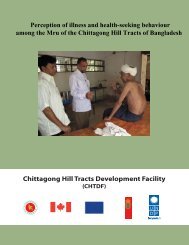Socio-economic Baseline Survey of Chittagong Hill Tracts - chtdf
Socio-economic Baseline Survey of Chittagong Hill Tracts - chtdf
Socio-economic Baseline Survey of Chittagong Hill Tracts - chtdf
- No tags were found...
You also want an ePaper? Increase the reach of your titles
YUMPU automatically turns print PDFs into web optimized ePapers that Google loves.
HDRC<strong>Socio</strong>-<strong>economic</strong> <strong>Baseline</strong> <strong>Survey</strong> <strong>of</strong> <strong>Chittagong</strong> <strong>Hill</strong> <strong>Tracts</strong>6than a decade before it culminated through signing <strong>of</strong> CHT Treaty in 1997. However, it is tobe noted that the level <strong>of</strong> persuasion varied during the terms <strong>of</strong> different governments, wasrelated to political commitment <strong>of</strong> the latter to the causes <strong>of</strong> establishing peace anddevelopment in CHT.Administratively, CHT comprises <strong>of</strong> three hill districts: Banadarban (4479 sq. km.),Khagrachari (2699 sq. km.), and Rangamati (6116 sq. km.). The three hill districts comprise<strong>of</strong> seven main valleys formed by the Feni, Karnafuli, Chengi, Myni, Kassalong, Sangu andMatamuhuri rivers and their tributaries, and numerous hills (Kiukarotlang,Chinchirmawitlang, and Chimbuk), ravines and cliffs covered with dense vegetation (trees,bush, creeper jungles etc.) which are in complete contrast to most <strong>of</strong> the other districts <strong>of</strong>Bangladesh consisting mainly <strong>of</strong> plain alluvial land. Bandarban district comprises <strong>of</strong> 7upazilas (sub-disricts), 29 unions (smallest administrative units), 97 mouzas (revenue units)and 1501 paras (villages). There are 8 upazilas, 34 unions, 120 mouzas and 1581 paras inKhagrachori; and 10 upazilas, 48 unions, 162 mouzas and 1344 paras in Rangamati district.However, beside formal administrative structure 13 <strong>of</strong> the region, the CHT is traditionallydivided into three circles: (i) Chakma Circle, (ii) Mong Circle, and (iii) Bhomong Circle.Each <strong>of</strong> the circles is headed by a Circle Chief 14 , traditionally known as Raja (king). TheCircle Chiefs are entrusted with the collection <strong>of</strong> taxes, and empowered to resolve conflictsand dispense justice in ‘tribal’ courts in accordance with the customary laws <strong>of</strong> theindigenous peoples (IPs) living under their respective jurisdictions. The circle chiefs arerepresented at the mouza level by a Headman and at the para level by a Karbari.According to the CHT Regulation 1900 (section 7), the “general” administration <strong>of</strong> the CHTin civil, criminal, revenue and “all other matters” is vested in the Deputy Commissioner (DC,who is a government –appointed functionally. The DC is obliged to act with the chiefs onimportant matters affecting the administration <strong>of</strong> the CHT (Rule 39, CHT Regulation) and aswell consult with the headman on matters <strong>of</strong> land and revenue. However, the efficacy <strong>of</strong> thispractice seems to vary in accordance with the nature <strong>of</strong> the relationship between theindividuals involved. In addition, there exists a <strong>Hill</strong> District Council (HDC’s) comprising <strong>of</strong>15 members and headed by a Chairperson 15 for the past two decades in each district <strong>of</strong> CHT.The regions general administration is vested in a number <strong>of</strong> authorities , including the DC,Chiefs and Headman, and the HDC’s, although the DC’s role is still perhaps the mostauthoritative on account <strong>of</strong> his powers over land matters, “law and order “ and the issuance <strong>of</strong>licenses and permits for trade and commerce and the extraction <strong>of</strong> natural resources. 16Moreover, since the signing <strong>of</strong> the CHT Accord in 1997, a <strong>Hill</strong> Regional Council headed by aChairperson (mandatorily from IPs) and 22 members (with two-thirds from among the IPs)has been constituted for overall coordination <strong>of</strong> administrative and developmental affairs inthe region.. According to the RC Act <strong>of</strong> 1998, the Regional Council (RC) also can formallyask the national government to remove any inconsistencies between the CHT Regulation <strong>of</strong>1900and other laws. However this legislative role <strong>of</strong> RC is yet to been seen in practice. 1713 District headed by Deputy Commissioner, Upazila by UNO, and Union by UP Chairman.14 Since 1881, the Government established the formal structure <strong>of</strong> traditional authority among the indigenous peoples inCHT which is in force till date (for details, see Adnan 2004).15 Members and Chairpersons <strong>of</strong> all these councils according to law are to be elected. However, till date the councils arefunctioning by the ad hoc appointees.16 Roy, 200017 Roy ibid.



